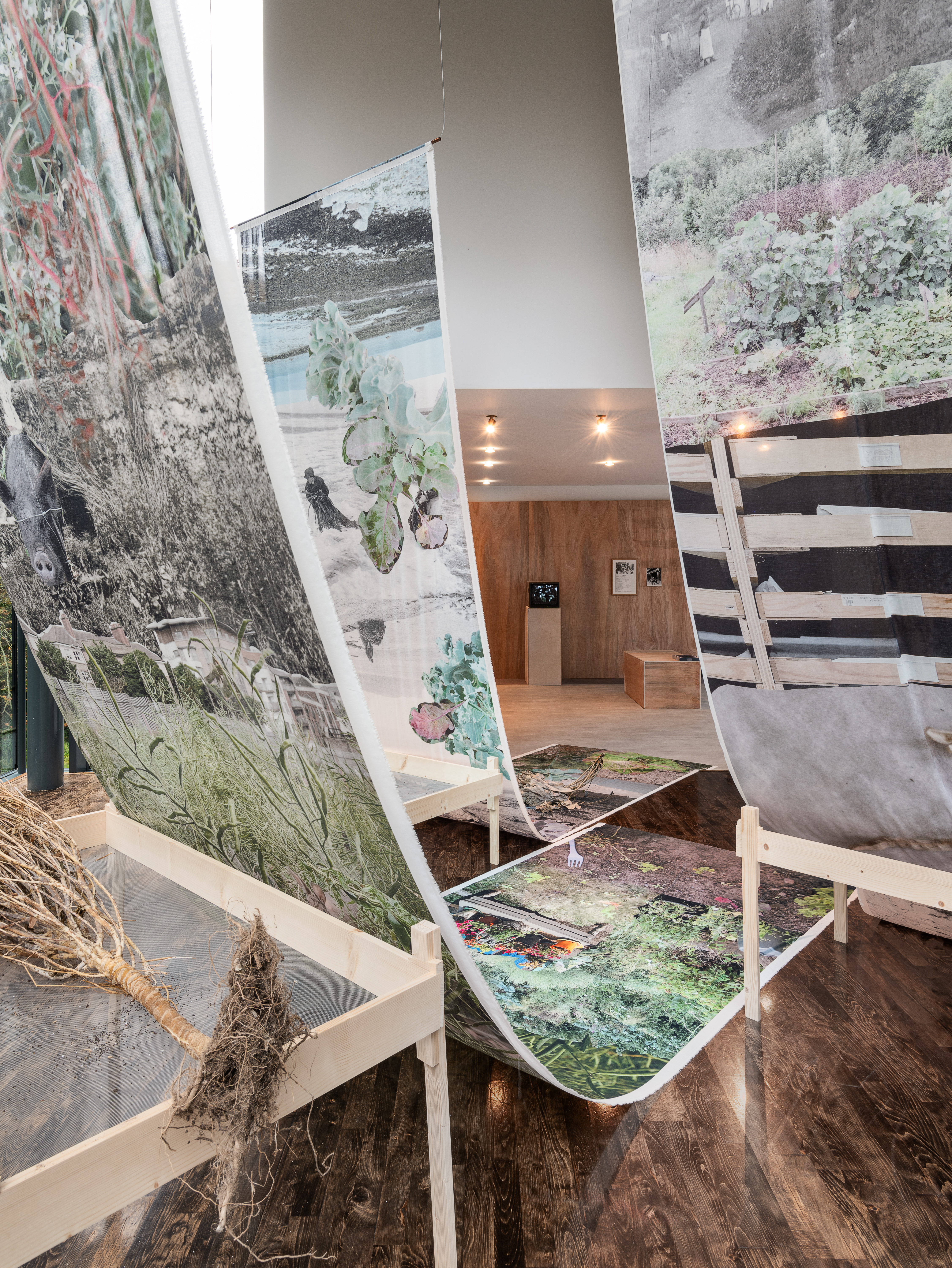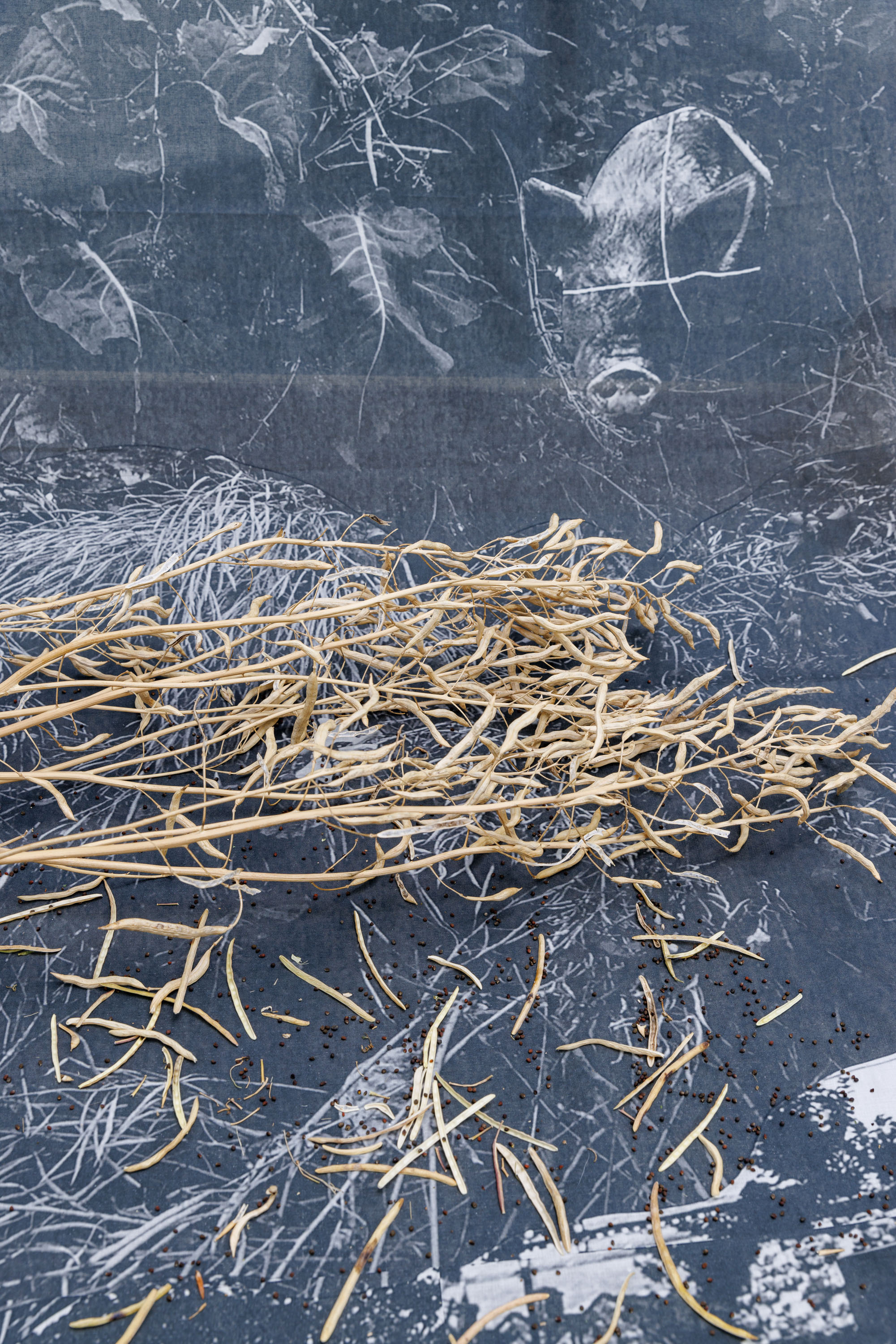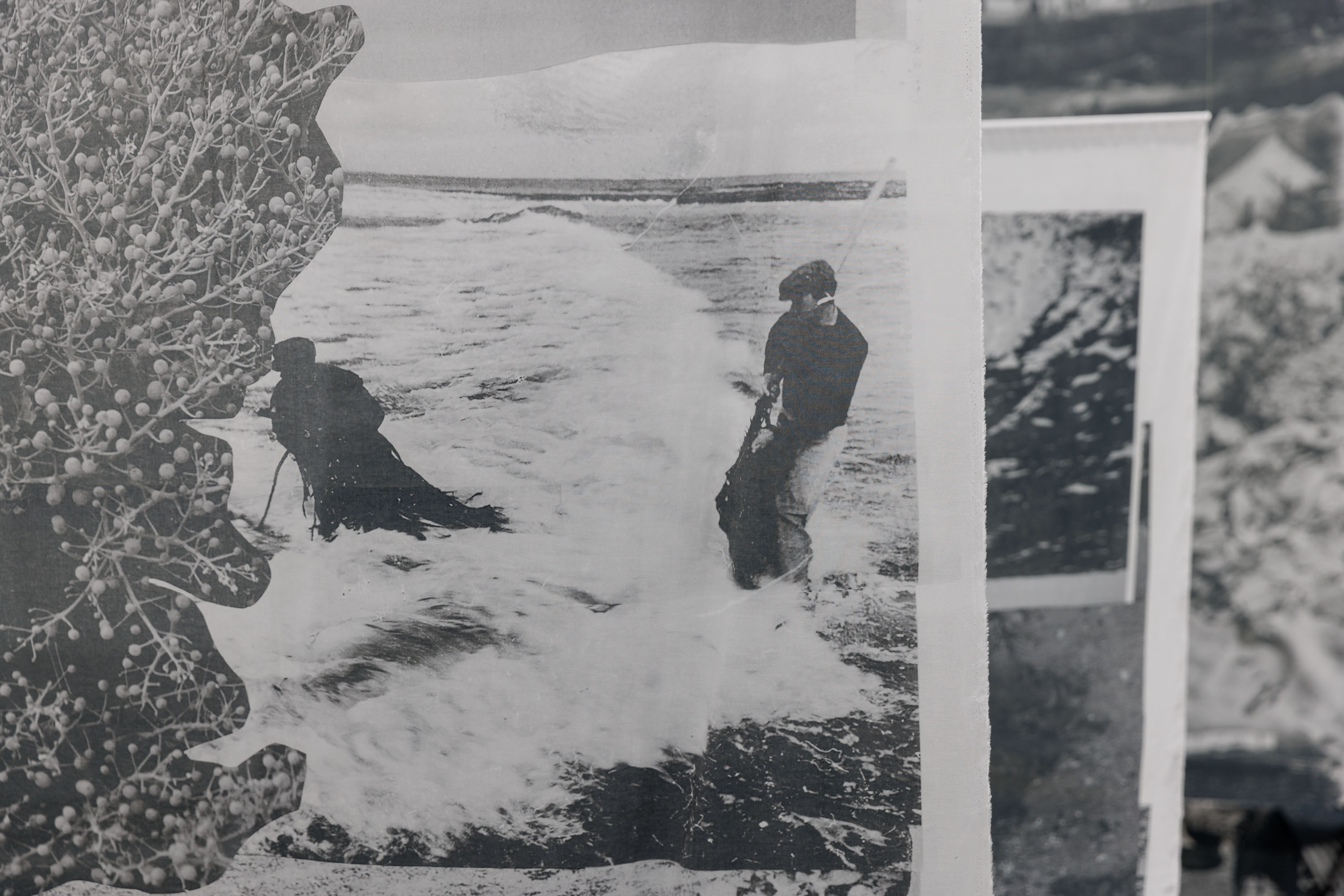The Kale Bed is so Called Because there is Always Kale in it




The Kale Bed is so Called Because there is Always Kale in it by Åsa Sonjasdotter and Mercè Torres Ràfols, in collaboration with NCAD FIELD and The Irish Seed Savers. Presented together with FOOD by Gordon Matta-Clarke, 1971. 40th Eva International, Limerick, Ireland, 2023.





Installation by artist and photographer Mercè Torres Ràfols and artist and researcher Åsa Sonjasdotter. Badischer Kunstverien, 2023. Photograpy by Felix Grünschloß.
The elements in this installation refer to the practice of seed saving such as large cloths onto which the seeds can drop, strainers, fragments of photographic and other documentary material, dried pods of flowers, as well as the colour spectre of kales.

The ‘far field’ is so called because it is the fartherest [sic] away from the house. The ‘home’ is so called because it lies beside the river. The ‘field behind the byre’ is so called because it lies beside the byre. ‘The wee point’ is so called because it is the smallest field on the farm. ‘The kale bead [sic]’ is so called because there was always kale in it. ‘The grazing’ is so called because sheep and cattle graze on it. In this district I know of the following. The Black Rock, Grey Rock and Gracies Rock. The Black Rock is so called because it is a black colour. The Grey Rock is so called because it is a black, Grey colour. Gracies Rock is so called because there was a woman named Gracie Dunlevy who lived there.
The Schools’ Collection, The National Folklore Collection, Ireland. Volume 1035, p. 381.
Kale is native to the Atlantic coast, and have throughout millennia been cultivated into a vast range of varieties in Ireland and beyond. With the British colonial powers’ centuries long oppression of peasants and land-workers in Ireland, almost only potatoes were afforded to be grown in smallholdings and cottage gardens. Potatoes yield generously and provides almost all the nutriments that humans’ need. However, when a blight damaged the yields in the years between 1845 and 1852, this led to the outbreak of the Great Famine. The hunger escalated at the same time as grains grown on the fields in control of the British landed estates were exported to England. With these violent occurrences, many household crops were lost in Ireland. Throughout the famine, however, Kale could rewild and continue to grow beyond the tended garden areas, from where it would provide nutriments also in situations of extreme scarcity.

Wild kale. Praiseach Trá, or Seakale. Photograph reproduced with the kind permission of the National Folklore Collection, University College Dublin.
Sea kale, known as strand cabbage or praiseach trá in Gaelic, is common on the shores of Britain, Ireland, the North Atlantic and the Mediterranean coasts of Europe. It grows on sandy, pebbly strands all around these coasts. It’s easy to recognize as it resembles a rough cabbage. Later in the year it will be covered with white flowers which become bobbly seed heads in autumn. As with mushrooms, people who know where to find patches of sea kale would guard them secretly.

Cultivated kale: Delaway Cabbage. Photograph by Carl Wilhelm von Sydow reproduced with the kind permission of the National Folklore Collection, University College Dublin.
The delicious, cold-hardy, cut-and-come-again Delaway Cabbage was kept for 6 decades in Charles Hughes’ family in County Mayo, Ireland. The family have been living on a farm in Lankill for eight generations and 250 years. An article in Mayo News titled ‘Legacy of Lankill’ by Áine Ryan documents the family history on the land: ‘Lankill (Lainn-Cilleadh) in Irish means a long narrow stripe of woodland which contains church grounds.’ Before the trees were cut down for export about 100 years ago there was a Mass rock (hidden stone altar) where the Catholic families would worship in secret covered by the forest. The family later survived the Battle of the Diamond in Armagh in 1798 and the Great Famine of the 1840s. They also held fast to their political and religious convictions and integrity during the Land War and the fight for Irish sovereignty and independence. The cabbage is a type of Brassica napus, which independent plant breeder Tim Peters predicts is a complicated cross between a European kale or cabbage (B. oleracea) and an Asian mustard (B. rapa), and perhaps crossed again with a black mustard (B. nigra). This ‘old world’ kale-cabbage found its way back to Ireland after long time in America. Some say these Siberian-Kale types came to Canada and then the US in the late 1800’s with Russian fur traders. Delaway Cabbage has now spent almost a century in the hands of dedicated seed savers on the West Coast of Ireland.
Rewilded Kale. Blackfoot Street Community Garden Kale. Photography by Åsa Sonjasdotter. 2018.
Specially bred for its’ pleasant texture and flavour, Blackfoot Street Community Garden Kale produces young crown leaves from November, and in spring leafy side shoots and spears that are picked like broccoli. This upright variety grows around 60cm (24in) tall and almost as wide, with thin, gently ruffled, dark petrol-green coloured leaves. The Bridgefoot Street Community Garden in Dublin was initiated by local residents in 2011 as the site was left derelict when a Public Private Partnership (PPP) deal was struck between the city council and a developer to build 200 apartments in a 13 story tower block. A thriving garden emerged on the 2 1/2 acre site between Thomas Street and the Quays, in the Oliver Bond area, right in the Dublin city centre. In December 2018, the Dublin City Council decided that the garden was to be closed as part of the council’s plan to refurbish the garden and the park beside it. The summer before the eviction of the Bridgefoot Street Community Garden, the garden flourished in an abundance of kale from the sturdy variety.
The research, production, and publishing of The Kale Bed is so Called Because there is Always Kale in it has been carried out by Åsa Sonjasdotter in Ireland and beyond since 2017, in support by and in collaboration with, various institutions and organisations including the Irish Seed Savers Association, Scarriff; the grassroot farmer led organisation Talamh Beo, The National Museum of Country Life, Turlough; The UCD School of Archaeology, Dublin; the FIELD of the National College of Art and Design (NCAD), Dublin; An Taisce, The National Trust for Ireland; Environmental Education Unit (Green Flag Award Scheme); the MA program of Art & Ecology at Goldsmiths, London, the UK; Archive Books, Berlin, Germany, and the Valand Academy, University of Gothenburg, Sweden.